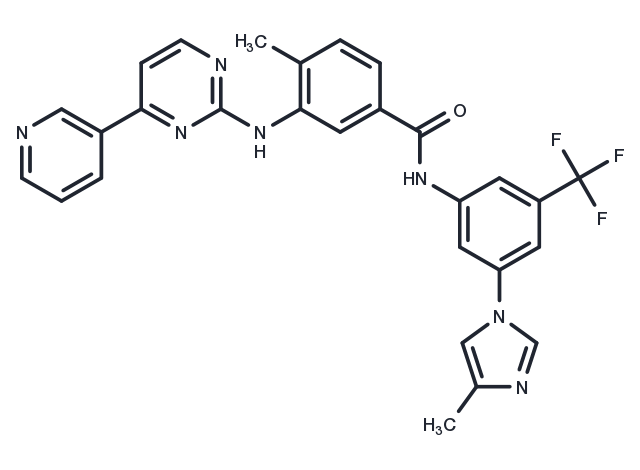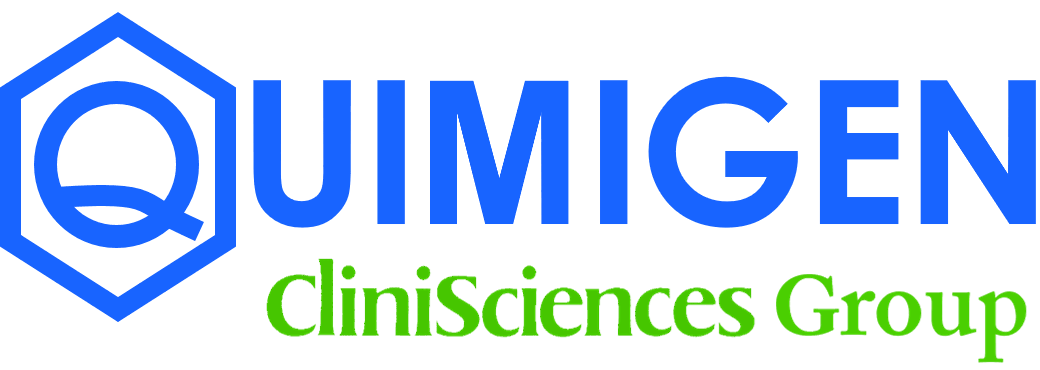Powder: -20°C for 3 years | In solvent: -80°C for 1 year
Nilotinib [641571-10-0]
Cat# T1524-1mL
Size : 1mL
Brand : TargetMol
Nilotinib
Catalog No. T1524 CAS 641571-10-0
Synonyms: Tasigna, AMN107
Nilotinib (AMN107) is a second-generation Bcr-Abl tyrosine kinase inhibitor with antineoplastic activity.
All products from TargetMol are for Research Use Only. Not for Human or Veterinary or Therapeutic Use.

Nilotinib, CAS 641571-10-0
| Description | Nilotinib (AMN107) is a second-generation Bcr-Abl tyrosine kinase inhibitor with antineoplastic activity. |
| Targets&IC50 | Abl (WT):15 nM (cell free) |
| In vitro | Nilotinib (AMN107) inhibited Abl-catalyzed peptide substrate phosphorylation with ~20-fold higher potency than imatinib (IC50: 15 versus 280 nmol/L). AMN107 inhibited the growth of cells expressing wild-type Bcr-Abl with 20-fold higher potency than imatinib (IC50: 13 versus 260 nmol/L) [1].Parent and imatinib-resistant GIST cell lines showed sensitivity to nilotinib in a concentration-dependent manner with the IC50 values of parent GIST cell lines being 3.15±0.31 μM for GK1C and 3.32±0.18 μM for GK3C (n.s.), and the imatinib-resistant cell lines showing IC50 values of 4.10±0.46 μM and 3.96±0.19 μM for GK1C-IR and GK3C-IR (n.s.), respectively [2]. Nilotinib inhibited proliferation, migration, and actin filament formation, as well as the expression of α-SMA and collagen in activated HSCs. Nilotinib induced apoptosis of HSCs. Nilotinib also induced cell cycle arrest, accompanied by increased expression of p27 and downregulation of cyclin D1 [3]. |
| In vivo | The percentage of tumor growth inhibition (TGI) was 69.6% for nilotinib in the GK1X xenograft line. In the GK2X xenograft line, TGI was 85.3% for nilotinib [2]. Imatinib and nilotinib attenuated the extent of lung injury and fibrosis. The numbers of inflammatory cells and levels of IL-6, IL-1β and tumor necrosis factor-α were decreased in the imatinib and nilotinib groups on days 3 and 7. Imatinib and nilotinib therapy significantly reduced the levels of hydroxyproline on days 14 and 21, which was accompanied by decreased expression levels of TGF-β1 and PDGFR-β [4]. |
| Kinase Assay | Kinase assays using wild-type and mutant glutathione S-transferase (GST)–Abl fusion proteins (c-Abl amino acids 220-498) were done as described, with minor alterations. GST-Abl fusion proteins were released from glutathione-Sepharose beads before use; the concentration of ATP was 5 μmol/L. Immediately before use in kinase autophosphorylation and in vitro peptide substrate phosphorylation assays, GST-Abl kinase domain fusion proteins were treated with LAR tyrosine phosphatase according to the manufacturer's instructions. After 1-hour incubation at 30°C, LAR phosphatase was inactivated by addition of sodium vanadate (1 mmol/L). Immunoblot analysis comparing untreated GST-Abl kinase to dephosphorylated GST-Abl kinase was routinely done using phosphotyrosine-specific antibody 4G10 to confirm complete (>95%) dephosphorylation of tyrosine residues and c-Abl antibody CST 2862 to confirm equal loading of GST-Abl kinase. The inhibitor concentration ranges for IC50 determinations were 0 to 5,000 nmol/L (imatinib and AMN107) or 0 to 32 nmol/L (BMS-354825). The BMS-354825 concentration range was extended to 1,000 nmol/L for mutant T315I. These same inhibitor concentrations were used for the in vitro peptide substrate phosphorylation assays. The three inhibitors were tested over these same concentration ranges against GST-Src kinase and GST-Lyn kinase [1]. |
| Cell Research | Ba/F3 cell lines were plated in triplicate and incubated with escalating concentrations of imatinib, AMN107, or BMS-354825 for 72 hours. Proliferation was measured using a methanethiosulfonate-based viability assay. IC50 and IC90 values are reported as the mean of three independent experiments done in quadruplicate. The inhibitor concentration ranges for IC50 and IC90 determinations were 0 to 2,000 nmol/L (imatinib and AMN107) or 0 to 32 nmol/L (BMS-354825). The imatinib concentration range was extended to 6,400 nmol/L for mutants with IC50 >2,000 nmol/L. The BMS-354825 concentration range was extended to 200 nmol/L for mutant T315I [1]. |
| Animal Research | The GIST xenograft lines GK1X, GK2X and GK3X in nude mice were established from GIST patients as described in our previous study [10]. These xenograft lines were maintained by continual passage in BALB/cSLc-nu/nu mice. Mice bearing GK1X, GK2X and GK3X tumors (6–8 mice per group) were treated daily with vehicle or 40 mg/kg imatinib or nilotinib for 4 weeks. Tumor volume (TV) was determined from caliper measurements of tumor length (L) and width (w) according to the formula LW2/2. TV was determined every two to three days and on the day of evaluation. Mice were sacrificed and the percentage of tumor growth inhibition (TGI) was calculated as follows: TGI (%) ?=? [1– (mean of treatment group tumor volume on evaluation day – mean of treatment group tumor volume on day 1)/(mean of control group tumor volume on evaluation day – mean of control group tumor volume on day 1)]×100 [2]. |
| Synonyms | Tasigna, AMN107 |
| Molecular Weight | 529.52 |
| Formula | C28H22F3N7O |
| CAS No. | 641571-10-0 |
Storage
Solubility Information
H2O: < 1 mg/mL (insoluble or slightly soluble)
Ethanol: < 1 mg/mL (insoluble or slightly soluble)
DMSO: 13.75 mg/mL (25.97 mM)
 References and Literature
References and Literature
1. O'Hare T, et al. In vitro activity of Bcr-Abl inhibitors AMN107 and BMS-354825 against clinically relevant imatinib-resistant Abl kinase domain mutants. Cancer Res. 2005 Jun 1;65(11):4500-5. 2. Sako H, et al. Antitumor effect of the tyrosine kinase inhibitor Nilotinib on gastrointestinal stromal tumor (GIST) and Imatinib-resistant GIST cells. PLoS One. 2014 Sep 15;9(9):e107613. 3. Liu Y, et al. Inhibition of PDGF, TGF-β, and Abl signaling and reduction of liver fibrosis by the small molecule Bcr-Abl tyrosine kinase antagonist Nilotinib. J Hepatol. 2011 Sep;55(3):612-625. 4. Rhee CK, et al. Effect of nilotinib on bleomycin-induced acute lung injury and pulmonary fibrosis in mice. Respiration. 2011;82(3):273-87. 6. Fujita KI, et al. Involvement of the Transporters P-Glycoprotein and Breast Cancer Resistance Protein in Dermal Distribution of the Multikinase Inhibitor Regorafenib and Its Active Metabolites. J Pharm Sci. 2017 Sep;106(9):2632-2641. 7. Sun R, Bao M Y, Long X, et al. Metabolic gene NR4A1 as a potential therapeutic target for non‐smoking female non‐small cell lung cancer patients[J]. Thoracic cancer. 2019 Apr;10(4):715-727. 8. Kuang Y, Chai Y, Xu L, et al. Glabrone as a specific UGT1A9 probe substrate and its application in discovering the inhibitor glycycoumarin[J]. European Journal of Pharmaceutical Sciences. 2021: 105786.
 Citations
Citations
1. Cheng S, Jin P, Li H, et al. Evaluation of CML TKI Induced Cardiovascular Toxicity and Development of Potential Rescue Strategies in a Zebrafish Model. Frontiers in Pharmacology. 2021: 2866. 2. Kuang Y, Chai Y, Xu L, et al. Glabrone as a specific UGT1A9 probe substrate and its application in discovering the inhibitor glycycoumarin. European Journal of Pharmaceutical Sciences. 2021: 105786. 3. Sun R, Bao M Y, Long X, et al. Metabolic gene NR4A1 as a potential therapeutic target for non‐smoking female non‐small cell lung cancer patients. Thoracic Cancer. 2019 Apr;10(4):715-727 4. Yan H, Wu W, Hu Y, et al.Regorafenib inhibits EphA2 phosphorylation and leads to liver damage via the ERK/MDM2/p53 axis.Nature Communications.2023, 14(1): 2756. 5. Liu T, Yue X, Chen X, et al.Nilotinib in combination with sunitinib renders MCL-1 for degradation and activates autophagy that overcomes sunitinib resistance in renal cell carcinoma.Cellular Oncology.2024: 1-18.



